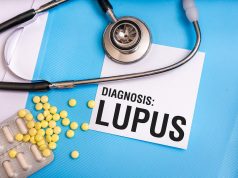The European League Against Rheumatism 2016 Annual European Congress of Rheumatology
The annual meeting of the European League Against Rheumatism was held from June 8 to 11 in London and attracted approximately 15,000 participants from around the world, including clinicians, academicians, allied health professionals, and others interested in rheumatology. The conference highlighted recent advances in the prevention, detection, and treatment of rheumatic diseases.
In one study, Maria Fernanda Goulart, M.D., of the University of São Paulo in Brazil, and colleagues evaluated nine children and adolescents with lupus living in the São Paulo metropolitan area during a one-year period. The investigators collected a total of 108 samples and evaluated levels of fractional exhaled nitric oxide (FeNO), exhaled breath concentration (EBC pH), and disease activity parameters. The investigators determined the association between these parameters and exposure to air pollution composed of inhaled fine particles and nitrogen dioxide (NO2).
“We concluded that the children and adolescents were exposed to a mean daily concentration of inhaled fine particles of 40.9 µg/m³, which was higher than the daily World Health Organization standard of 25 µg/m³,” Goulart said. “The increase of FeNO related to inhaled fine particles was observed in the first three days after exposure and also in NO2 seven-day cumulative concentration, suggesting that airway inflammation may be related to air pollution in these patients.”
In addition, the researchers found that EBC pH decreased after exposure to inhaled fine particles, suggesting that airway inflammation after exposure may be related to airway acidification.
“Our findings have shown that air pollution doesn’t just increase the incidence and prevalence of chronic lung disease and acute respiratory infections, lung cancer, heart disease, and strokes, it is also an important contributory factor in childhood rheumatic diseases, such as lupus,” Goulart added.
In another study, Leslie R. Harrold, M.D., of the University of Massachusetts in Worcester, and colleagues evaluated treatment response based on anti-CCP antibodies and rheumatoid factors (RF) in abatacept and tumor necrosis factor-inhibitor (TNFi) initiators with a six-month follow-up. The investigators evaluated responses based on serologic status defined as double positive (anti-CCP+/RF+), single positive (CCP+/RF or CCP/RF+), and double negative (CCP/RF). The investigators found that a response to abatacept was related to serologic status, while a response to TNFi was not.
“These real-world data demonstrate that baseline anti-CCP+/RF+ is associated with better clinical response to abatacept, with the strongest association observed for double seropositivity. In contrast, no relationship was evident between anti-CCP/RF status and response to a TNFi. Further analyses revealed the results were being driven by anti-CCP serologic status and that RF was not independently associated with response,” Harrold said. “Future analyses should include a head-to-head comparison of abatacept and TNFi based on serologic status, as well as a look at longer term outcomes.”
John Ioannou, Ph.D., of University College London, and colleagues found an association between mood and disease outcomes in teenagers with juvenile inflammatory arthritis, with low mood at diagnosis associating with ongoing pain and disability in the future.
“These findings underpin the importance of psychological assessment and support, where appropriate, being made available to all young people diagnosed with juvenile inflammatory arthritis,” Ioannou said. “Further prospective studies are necessary to determine whether early psychological support for those who require it improves future outcomes.”
Copyright © 2016 HealthDay. All rights reserved.







